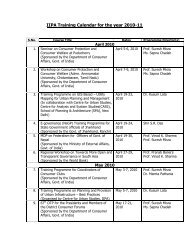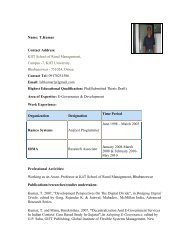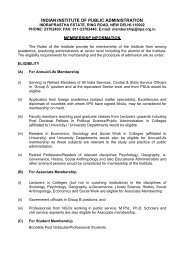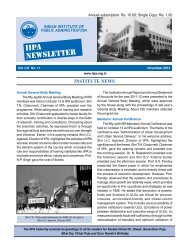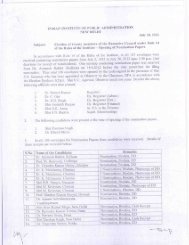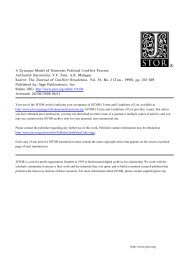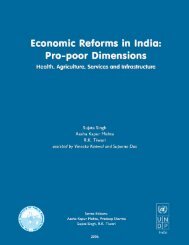Subcontracting and Economic - Indian Institute of Public Administration
Subcontracting and Economic - Indian Institute of Public Administration
Subcontracting and Economic - Indian Institute of Public Administration
You also want an ePaper? Increase the reach of your titles
YUMPU automatically turns print PDFs into web optimized ePapers that Google loves.
Agro-Based Industries in India <strong>and</strong> <strong>Subcontracting</strong><br />
1135 proposals for joint ventures; foreign collaboration,<br />
industrial licenses <strong>and</strong> 100 percent export oriented<br />
units envisaging an investment <strong>of</strong> Rs 194 billion (US $<br />
4.1 billion).<br />
• Foreign investment in the sector has been comp<br />
aratively more encouraging with 24 percent <strong>of</strong> the<br />
proposed projects implemented. Total foreign investment<br />
upto December 2000 in the Food Processing<br />
sector has been Rs 26 billion.<br />
Apart from the above facts, one may note the following<br />
as revealed by the Five-Year Plan drafts <strong>of</strong> the Planning<br />
Commission <strong>of</strong> India:<br />
• India is now the largest producer <strong>of</strong> milk.<br />
• India is the second largest producer <strong>of</strong> fruits <strong>and</strong><br />
vegetables.<br />
• In India, only 2 percent <strong>of</strong> fruits <strong>and</strong> vegetables are<br />
processed as opposed to 80 percent in Brazil, 80 percent<br />
in Philippines, 83 percent in Malaysia <strong>and</strong> 30 percent<br />
in Thail<strong>and</strong>.<br />
• In 1996, only 35 percent <strong>of</strong> installed capacity was<br />
utilised in the food-processing industry, mainly due<br />
to a narrow product base, technological obsolescence,<br />
high cost <strong>and</strong> poor quality <strong>of</strong> raw materials.<br />
• The bakery sector is the largest sector <strong>of</strong> the processed<br />
food industry, although in 1996, per capita consumption<br />
<strong>of</strong> bread in India was 1.4 kilograms a year compared<br />
to 25 kilograms in USA.<br />
• In 1996, the food processing industry contributed 19<br />
percent <strong>of</strong> the industrial GDP, but got only 5.2 percent<br />
<strong>of</strong> total industrial investment.<br />
• The major impediments in the expansion <strong>of</strong> the food<br />
processing industry are lack <strong>of</strong> good quality <strong>and</strong> hygienic<br />
raw materials, poor technology, low investment<br />
<strong>and</strong> absence <strong>of</strong> large industries.<br />
The above description makes it clear that among the agrobased<br />
industries, the food-processing industry has a huge<br />
potential for development. <strong>Subcontracting</strong> in food-processing<br />
industries can be successful provided large firms<br />
enter this sector <strong>and</strong> develop a cluster <strong>of</strong> small firms around<br />
them. The small firms are in a better position to get the<br />
raw materials from the farmers <strong>and</strong> bring them to the<br />
production location. This saves transaction costs in terms<br />
<strong>of</strong> distance, time <strong>and</strong> monitoring. Some large firms in India<br />
have started production through a network <strong>of</strong> small<br />
firms. Mention may be made <strong>of</strong> ITC Agro, Dabur,<br />
Hindustan Lever <strong>and</strong> Nestle. The first one has entered the<br />
processed wheat, ready-to-eat meals <strong>and</strong> bakery segments,<br />
while Dabur has entered the processed fruit drink segment.<br />
Hindustan Lever has captured a large part <strong>of</strong> the<br />
jam <strong>and</strong> jelly segment <strong>of</strong> the <strong>Indian</strong> market. Nestle is doing<br />
good business in pasta <strong>and</strong> sauce products.<br />
In order for the subcontracting relationship to succeed in<br />
the food-processing segment, one must have a clear idea<br />
about two aspects <strong>of</strong> subcontracting, namely:<br />
1. Theoretical underpinning <strong>of</strong> having a successful subcontracting<br />
relationship; <strong>and</strong><br />
2. The need to incorporate changes in the existing laws<br />
<strong>of</strong> contract to accommodate subcontracting.<br />
13




